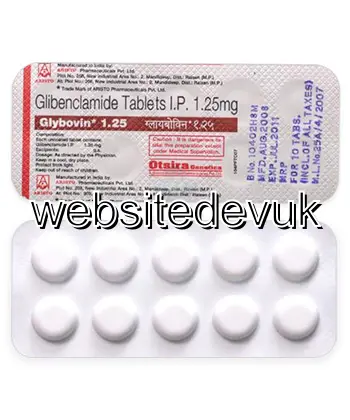| Package | Dosage | Price | Price per Dose | |
|---|---|---|---|---|
| Dosage: 2,5mg | ||||
| 360 pill | 2,5mg | £179.75 | £0.50 | |
| 180 pill | 2,5mg | £96.71 | £0.54 | |
| 120 pill | 2,5mg | £69.35 | £0.58 | |
| 90 pill | 2,5mg | £56.65 | £0.63 | |
| 60 pill | 2,5mg | £41.02 | £0.68 | |
| 30 pill | 2,5mg | £24.41 | £0.81 | |
| Dosage: 5mg | ||||
| 360 pill | 5mg | £158.25 | £0.44 | |
| 180 pill | 5mg | £91.82 | £0.51 | |
| 120 pill | 5mg | £64.47 | £0.54 | |
| 90 pill | 5mg | £50.79 | £0.57 | |
| 60 pill | 5mg | £35.16 | £0.59 | |
| 30 pill | 5mg | £20.51 | £0.68 | |

Glibenclamide Description
Overview of Glibenclamide
Glibenclamide, also known as glyburide, is an oral medication used primarily to manage type 2 diabetes mellitus. It belongs to the class of drugs called sulfonylureas. This medication works by stimulating the pancreas to produce more insulin, which helps lower blood sugar levels. Its effectiveness has made it a popular choice for many patients seeking to control their blood glucose. However, like all medications, Glibenclamide has both benefits and potential risks that need to be carefully considered.
How Glibenclamide Works
The active ingredient in Glibenclamide enhances insulin secretion through the closure of ATP-sensitive potassium channels in pancreatic beta cells. This process triggers the release of insulin, which in turn helps reduce elevated blood glucose levels. For patients with type 2 diabetes, especially those who produce some insulin but not enough to meet their body's needs, Glibenclamide can significantly improve glycemic control. It is typically used alongside diet and exercise modifications, and sometimes in combination with other antidiabetic medications.
Benefits of Using Glibenclamide
Many users find Glibenclamide effective in managing their blood sugar levels over the long term. The drug’s ability to stimulate insulin production makes it particularly useful for individuals with residual pancreatic function. It can also improve overall metabolic parameters, potentially reducing the risk of diabetes-related complications such as nerve damage, kidney problems, and eye issues. Moreover, its once-daily dosing schedule adds to user convenience, promoting better adherence to therapy.
Possible Side Effects and Risks
While Glibenclamide is effective, it is not without side effects. Hypoglycemia, or low blood sugar, is the most common and serious adverse effect. Symptoms may include sweating, dizziness, hunger, confusion, and in severe cases, loss of consciousness. Allergic reactions such as rash and itching can also occur. Some users may experience gastrointestinal discomfort, weight gain, or skin reactions. Long-term use requires careful monitoring to avoid any dangerous drops in blood glucose levels. It is especially important for patients with impaired kidney or liver function to consult their healthcare provider before starting this medication.
Precautions and Interactions
Before taking Glibenclamide, patients should inform their doctor about all other medications they are using, including over-the-counter drugs and supplements. Certain medicines, like diuretics, antibiotics, or other antidiabetic agents, may interact resulting in either increased risk of hypoglycemia or reduced effectiveness of Glibenclamide. Patients with a history of liver or kidney disease, or those who are pregnant or breastfeeding, should seek medical advice before beginning therapy. Proper diet, regular blood glucose monitoring, and adherence to prescribed doses are essential for safety and efficacy.
Summary of Patient Experience
Many patients report feeling better controlling their blood sugar with Glibenclamide. With proper medical guidance, it can lead to stable glucose levels and improved quality of life. Nevertheless, monitoring for side effects, especially hypoglycemia, remains crucial. Patients often appreciate the simplicity of once-daily dosing and the drug's proven track record in diabetes management. That said, individual responses vary, and some may need adjustments or additional medications to achieve optimal control.